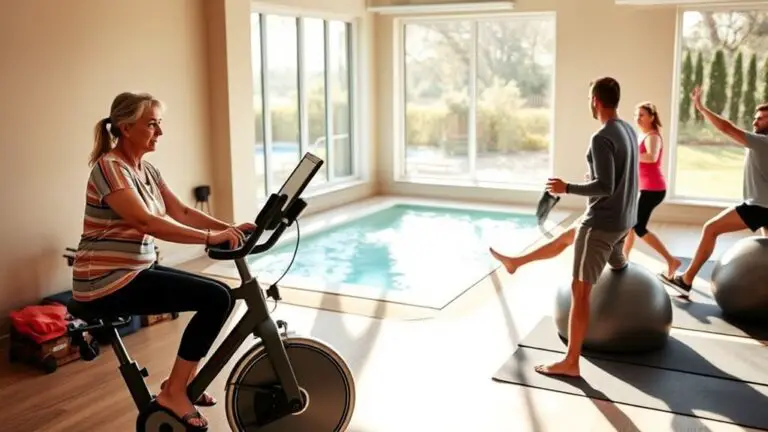How to Train Your Forearms for Grip Strength
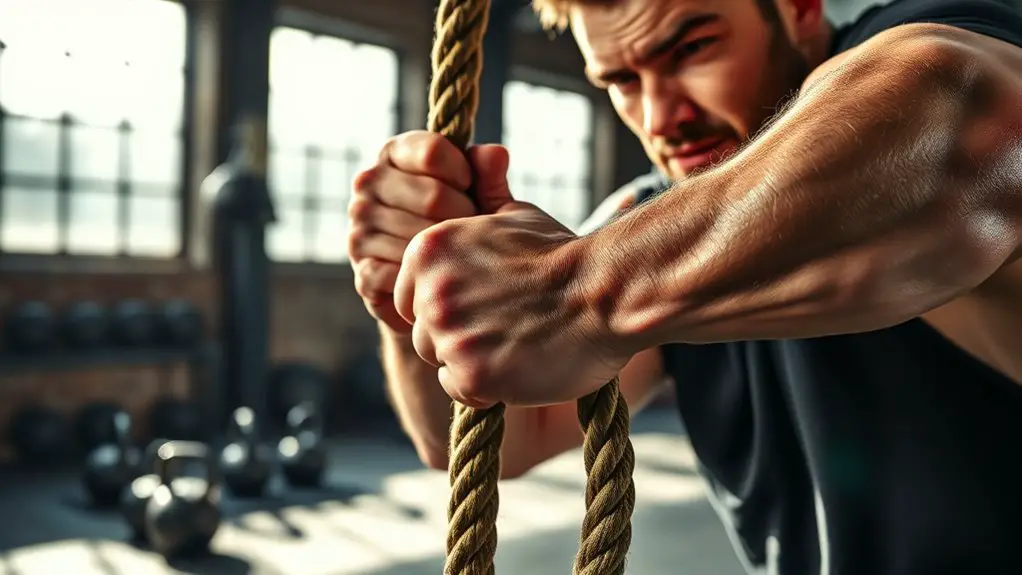
To train your forearms for grip strength, incorporate exercises like wrist curls and farmer’s walks into your routine. Use different grip styles and tools like hand grippers to enhance your workouts. Aim for two to three grip training sessions each week and focus on maintaining proper form to avoid strain. Allow for recovery time between sessions to maximize effectiveness. There’s plenty more to explore about optimizing your approach and achieving the best results.
Understanding Grip Strength and Its Importance
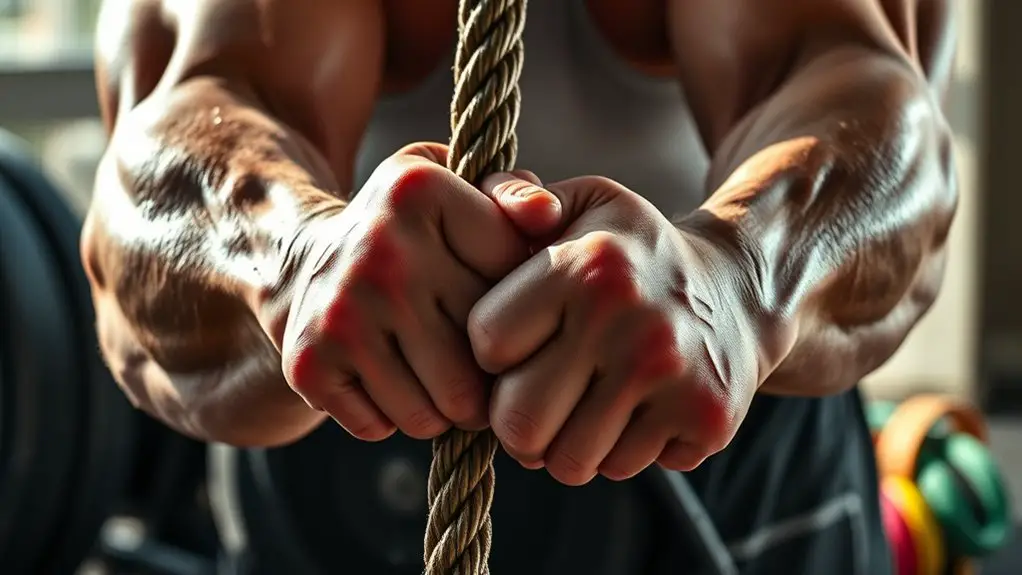
Grip strength is a fundamental aspect of overall fitness that often gets overlooked. It’s essential for daily activities, from opening jars to lifting weights safely. Understanding the different grip types—like the crush grip, pinch grip, and support grip—can help you tailor your training for maximum strength benefits. Each grip type engages various muscles in your forearms and hands, contributing to overall hand functionality and stability.
Effective Forearm Exercises for Increased Strength
Building grip strength requires targeted exercises that specifically engage the muscles in your forearms and hands. One effective exercise is wrist curls. To perform them, sit on a bench, rest your forearms on your thighs, and hold a dumbbell in each hand. Slowly curl your wrists upward, then lower them back down. Start with light weights to avoid strain and gradually increase as you get stronger.
Another great option is farmer’s walks. Grab a pair of heavy dumbbells or kettlebells and walk a set distance. Keep your shoulders back and maintain a strong grip while moving. This exercise not only strengthens your forearms but also engages your core and improves overall stability.
Always prioritize good form and listen to your body to prevent injuries. Incorporating these exercises into your routine will help you build the grip strength you need for various activities and sports.
Incorporating Grip Training Into Your Routine
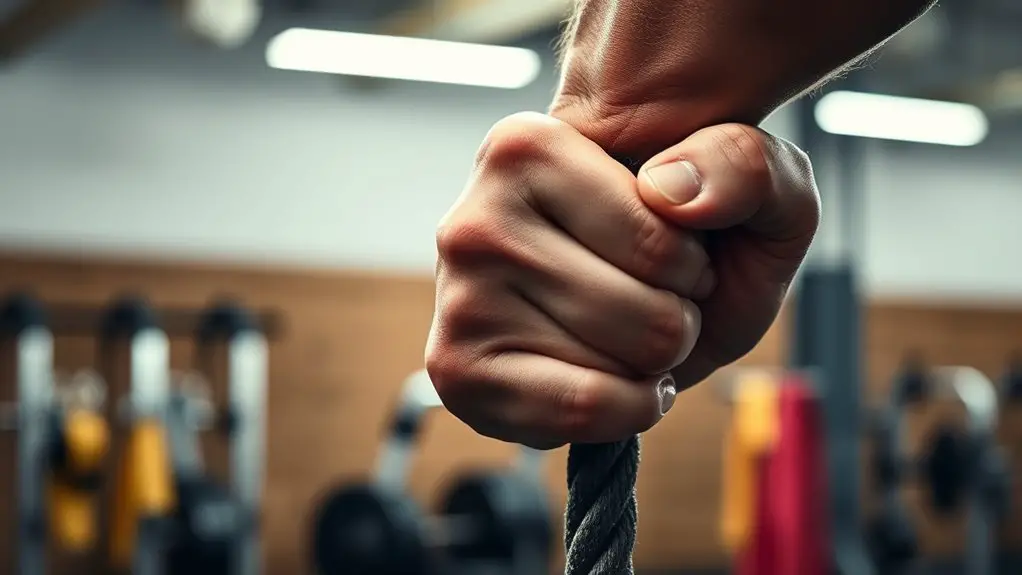
While many people focus on major muscle groups during their workouts, integrating grip training can enhance your overall strength and performance. By incorporating grip tools into your routine, you can effectively build your forearm muscles and improve your grip strength. Here are some strategies to contemplate:
- Start with two to three dedicated grip training sessions per week to establish a solid foundation.
- Incorporate grip tools like hand grippers, wrist rollers, or even a towel for dead hangs to diversify your training.
- Gradually increase your training frequency and intensity to avoid overexertion and guarantee safe progress.
Tips for Maximizing Your Forearm Workouts
To truly enhance your forearm workouts, it’s important to focus on both technique and variety. Start by understanding your forearm anatomy; this knowledge helps you target specific muscles effectively. Incorporate different grip styles—like overhand, underhand, and neutral grips—to guarantee balanced development and prevent overuse injuries.
Using grip accessories can further amplify your results. Consider adding tools like wrist rollers, grip strengtheners, or fat grip attachments to your routine. These accessories not only challenge your grip but also engage the forearm muscles in new ways.
Moreover, prioritize proper form during exercises. When lifting weights or using accessories, maintain a controlled motion to avoid strain. Finally, allow adequate rest between sessions to promote recovery and growth. By combining these strategies, you’ll maximize your forearm workouts while keeping safety at the forefront.
Common Mistakes to Avoid in Forearm Training
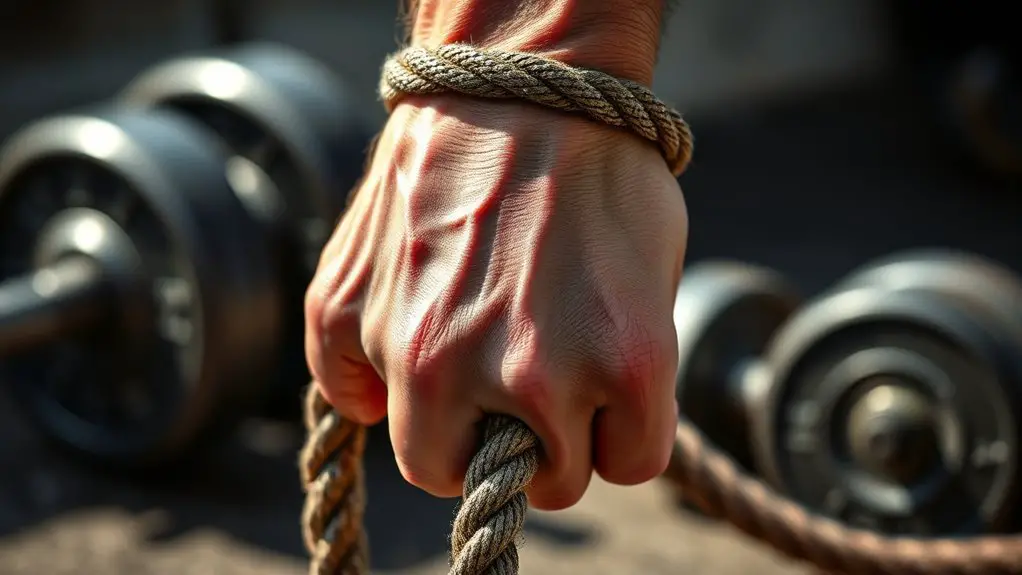
Even though forearm training might seem straightforward, many people make common mistakes that can hinder progress or lead to injury. To guarantee you’re making the most of your workouts, keep these points in mind:
- Neglecting proper exercise form: Poor form can lead to ineffective training and increase your risk of injury. Always prioritize technique over weight.
- Ignoring overtraining issues: It’s easy to get carried away with intensity and frequency. Remember to allow your forearms adequate recovery time to avoid fatigue and strain.
- Skipping warm-ups: Warming up prepares your muscles and joints, reducing the risk of injury. Don’t overlook this vital step before diving into your workout.
Frequently Asked Questions
How Often Should I Train My Forearms Each Week?
If you’re focused on forearm fitness, finding your perfect training frequency is essential. You should aim to incorporate forearm exercises two to three times a week. This allows ample recovery time for muscle growth without risking overuse injuries. Always listen to your body and adjust as needed; safety’s paramount in any training regime. Remember, consistency is vital, but so is giving your muscles the rest they require to thrive and strengthen.
Can Grip Strength Improve My Overall Athletic Performance?
Absolutely, grip strength can greatly enhance your overall athletic performance. When you’ve got a strong grip, it allows for better control and stability in various movements, which can lead to improved technique and efficiency. This not only boosts your performance but also contributes to athletic longevity, reducing the risk of injury. By focusing on grip strength, you’re setting yourself up for safer, more effective training sessions and more successful outcomes in your sport.
What Equipment Do I Need for Forearm Training?
For effective forearm training, you’ll need a few essential pieces of equipment. Start with grip tools like hand grippers, which help build strength and endurance. A pair of dumbbells is also beneficial for various forearm exercises, including wrist curls and reverse curls. Finally, consider resistance bands for versatility and safety, allowing you to control your movements. Remember, always prioritize proper form to prevent injury while enhancing your grip strength.
Are There Any Dietary Recommendations for Grip Strength?
When it comes to boosting grip strength, diet plays a key role. You should focus on quality protein sources like lean meats, eggs, and legumes to support muscle growth. Don’t forget the importance of hydration; staying well-hydrated can enhance performance and recovery. Incorporating foods rich in vitamins and minerals will also help your overall strength. Remember, a balanced diet combined with proper training is essential for ideal results in any fitness journey.
How Long Does It Take to See Results in Grip Strength?
When it comes to grip strength, you might wonder how long it takes to see results. Progress timelines can vary widely due to individual variability, such as your current fitness level and consistency. Generally, you could start noticing improvements in a few weeks, but significant gains might take a couple of months. Just remember to focus on safe techniques and listen to your body to avoid injuries while you train.
